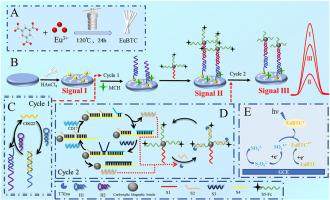使用镧系铕纳米棒的双周期放大电化学发光生物传感器用于超灵敏产前检测地中海贫血突变
IF 6
2区 化学
Q1 CHEMISTRY, ANALYTICAL
引用次数: 0
摘要
在此,我们开发了一种双周期放大的开关电化学发光(ECL)生物传感器,用于超灵敏的产前检测地中海贫血突变。该生物传感器利用水热合成的镧系铕纳米棒(EuBTC),具有丰富的活性位点,与传统的球形mof相比,电子传递效率提高了3.2倍。通过整合催化发夹组装和外切酶驱动的靶标循环扩增,该生物传感器在单次检测中实现了CD122 (β-珠蛋白IVS-II-654突变)和CD17 (β-珠蛋白密码子17突变)的序列检测。cha触发的二茂铁猝灭(信号关闭)使CD122定量检测限为0.739 fM,而T7外切酶介导的链位移恢复ECL信号(信号打开),CD17检测灵敏度为0.301 fM,比现有的基于pcr的方法提高了2-3个数量级。经实际产妇血清样本验证,加样回收率为97.7% ~ 108.0%,相对标准偏差(RSD)为4.1%,证实了该方法在无创产前诊断中的可靠性。这种双信号调制策略,结合EuBTC的天线效应,通过可编程DNA序列替换为多路基因分析提供了一个通用平台。本文章由计算机程序翻译,如有差异,请以英文原文为准。


On-off-on electrochemiluminescence biosensor with dual-cycle amplification for ultrasensitive prenatal detection of thalassemia mutations using lanthanide europium nanorods
Herein, we develop an on-off-on electrochemiluminescence (ECL) biosensor with dual-cycle amplification for ultrasensitive prenatal detection of thalassemia mutations. The biosensor utilizes hydrothermally synthesized lanthanide europium nanorods (EuBTC), which possess abundant active sites and exhibit a 3.2-fold improvement in electron transfer efficiency compared to conventional spherical MOFs. By integrating catalytic hairpin assembly and exonuclease-driven target recycling amplification, the biosensor achieves sequential detection of CD122 (β-globin IVS-II-654 mutation) and CD17 (β-globin codon 17 mutation) in a single assay. The CHA-triggered ferrocene quenching (signal-off) enables CD122 quantification with 0.739 fM detection limit, while T7 exonuclease-mediated strand displacement restores ECL signals (signal-on) for CD17 detection at 0.301 fM sensitivity, representing 2-3 orders of magnitude improvement over existing PCR-based methods. Validation using actual maternal serum samples showed recoveries ranging from 97.7 % to 108.0 %, with relative standard deviation (RSD) < 4.1 %, confirming its reliability in non-invasive prenatal diagnosis. This dual-signal modulation strategy, combines with the antenna effect of EuBTC, provides a universal platform for multiplexed gene analysis through programmable DNA sequence replacement.
求助全文
通过发布文献求助,成功后即可免费获取论文全文。
去求助
来源期刊

Analytica Chimica Acta
化学-分析化学
CiteScore
10.40
自引率
6.50%
发文量
1081
审稿时长
38 days
期刊介绍:
Analytica Chimica Acta has an open access mirror journal Analytica Chimica Acta: X, sharing the same aims and scope, editorial team, submission system and rigorous peer review.
Analytica Chimica Acta provides a forum for the rapid publication of original research, and critical, comprehensive reviews dealing with all aspects of fundamental and applied modern analytical chemistry. The journal welcomes the submission of research papers which report studies concerning the development of new and significant analytical methodologies. In determining the suitability of submitted articles for publication, particular scrutiny will be placed on the degree of novelty and impact of the research and the extent to which it adds to the existing body of knowledge in analytical chemistry.
 求助内容:
求助内容: 应助结果提醒方式:
应助结果提醒方式:


